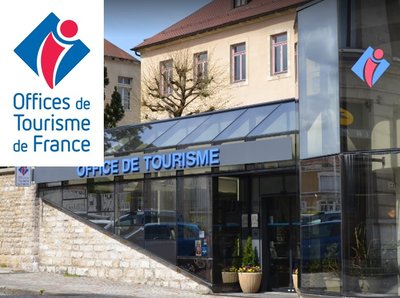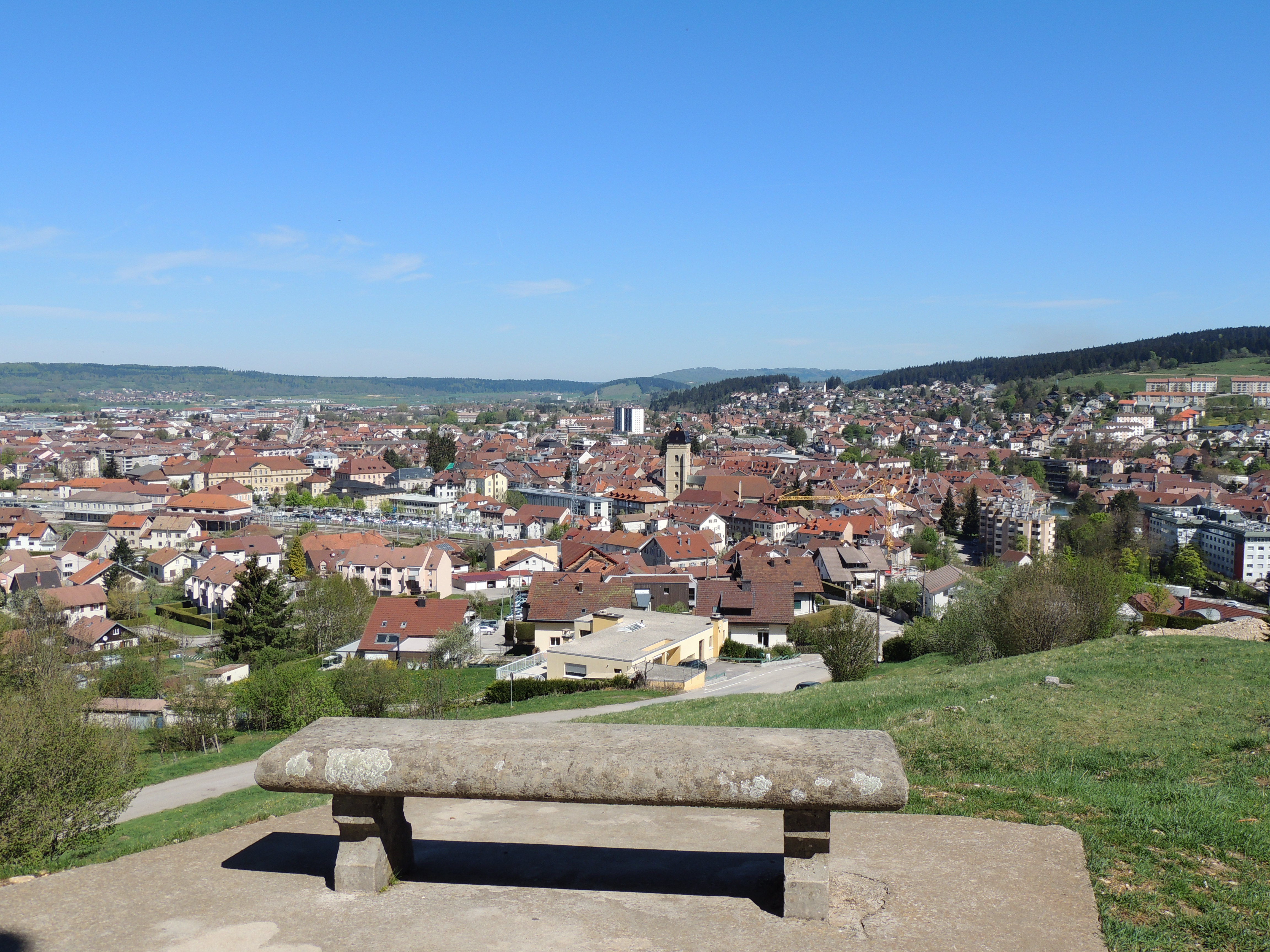
Pontarlier
A commercial crossing point and a former military barrier, with a landscape marked by religion and a medieval past, as the capital of absinthe, Pontarlier has no shortage of History and character in every corner.
15 points of interest
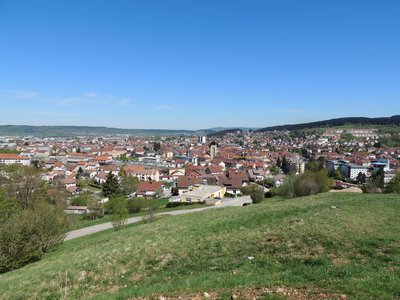
Pontarlier - PNRHJ - F.Jeanparis History & HeritagePontarlier
The history of Pontarlier is built around its advantageous geographical location: a crossroads during the Middle Ages between the North Sea and the Mediterranean Sea, it benefitted from passing trade but also suffered from military invasions. With many forests and a large amount of iron ore, this town was built on farming and craftmanship. Its border location enabled a constant flow of goods, people, know-how and capital. The opening of absinthe distilleries, sometimes in collaboration with Switzerland, generated a period of great prosperity in terms of the town’s development and cultural identity. (PNRHJ - Un tour en ville, “A tour of the town”)
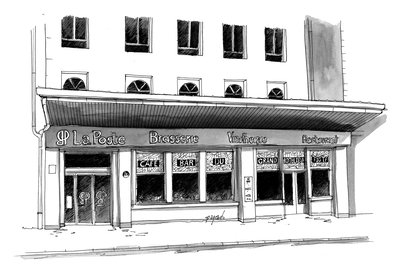
La brasserie La Poste - Illustration de François Pageaut History & HeritageLa Poste brewery
A former coach house, to which it owes its name, the La Poste brewery received the 20th Century Heritage label for its Art-Deco style. It is also famous for having been the place where “Septième Juré” starring Bernard Blier and “Les Granges Brûlées” starring Simone Signoret and Alain Delon were both filmed. (PNRH - Un tour en ville, “A tour of the town”)
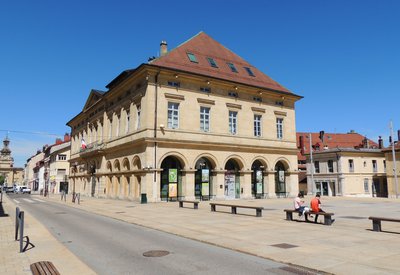
Place d'Arçon - PNRHJ - F. Jeanparis History & HeritagePlace d’Arçon
At the heart of the historic centre is the vast expanse offered by the Place d’Arçon where the town hall and the Pontarlier museum are both located. The first was completed in 1838 and originally housed an indoor market on the ground floor. The museum is located in one of the city’s oldest buildings, a combination of three houses, the oldest of which dates back to the 15th century. (PNRHJ - Un tour en ville, “A tour of the town”)
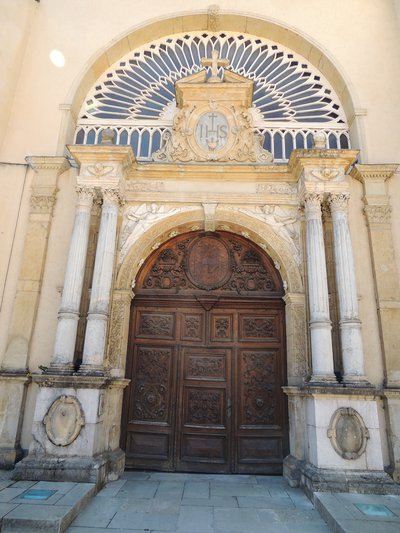
Chapelle des Annonciades - PNRHJ - F. Jeanparis History & HeritageThe Annonciades Chapel
The congregation of Les Annonciades Célestes de Pontarlier was established in 1609 by six young women from Pontarlier. The monastery’s baroque-style door, created by the sculptor Joseph Guyon, can still be admired. Its portal, which has been classed a historical monument, was completed in 1715 based on the plans set out by Nicolas Callier, an architect and entrepreneur from Besançon, and was later modified during the 19th century. (PNRHJ - Un tour en ville, “A tour of the town”)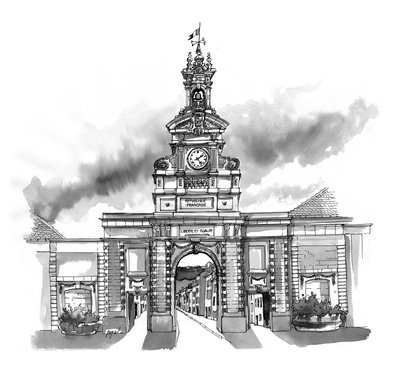
Porte Saint-Pierre - Illustration de François Pageaut History & HeritageThe Saint-Pierre entrance
Built in 1771 based on the design of the knight d’Arçon, to replace the entrance across the ramparts, the Saint-Pierre entrance is now one of the symbols of Pontarlier. Remodelled during the 12th century, it has kept its classical style and is listed on the Supplementary Inventory of Historical Monuments. Adorned with lines reminiscent of the Arc de Triomphe, the entrance appears like a crown atop the rue de la République and marks a symbolic transition from the more contemporary districts and the historic centre. (PNRHJ - Un tour en ville, “A tour of the town”)
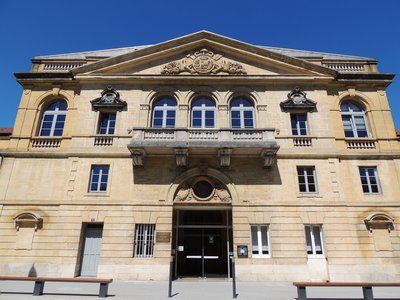
Théâtre B. Blier - PNRHJ - F. Jeanparis History & HeritageB. Blier theatre
During the early 20th century, the theatre was built as a reception hall above the Pontarlier market-hall. These market-halls are reminiscent of the large fairs that have been held in the city since the 13th century. During the 14th century, these fairs experienced a boom when the Col de Jougne (15 km south) became a commercial crossing point between the North Sea and the Mediterranean. (PNRHJ - Un tour en ville, “A tour of the town”)
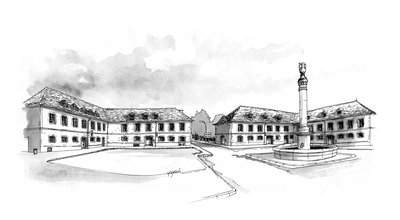
Les casernes Marguet - Illustration de François Pageaut History & HeritageThe Marguet barracks
These barracks, which were built with some of the money allocated by Louis XV to reconstruct Pontarlier after the fire in 1736, could house up to 200 men and just as many horses. The two L-shaped buildings were linked by a huge door, however, the municipality refused to close the square on the other side. This place was therefore split between a place of armament and a public place. In 1922, the door was removed, to allow for better circulation. (PNRHJ - Un tour en ville, “A tour of the town”)
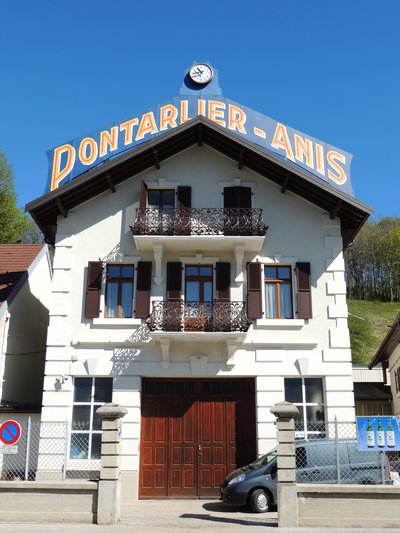
Distillerie Armand Guy - PNRHJ - F. Jeanparis History & HeritageArmand Guy distillery
Armand Guy distillery, now known as Pierre Guy, was founded in 1890 and is classed as a Living Heritage Enterprise. Much like Maison Pernod, it is passed down through the family, with four generations having already been at the reins. (PNRHJ - Un tour en ville, “A tour of the town”)
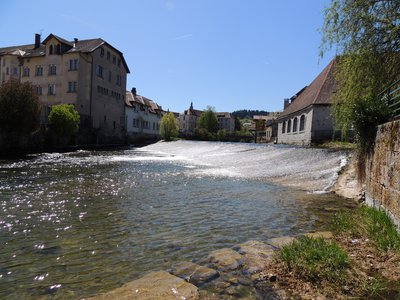
La rivière du Doubs - PNRHJ - F. Jeanparis Lakes & RiversThe Doubs and the Loue
In 1901, the Pernod factory - the largest absinthe distillery in the town - fell victim to a fire. With the alcohol reserves representing a risk of explosion, an employee decided to empty the reservoirs into the Doubs. Legend would have it that the merry inhabitants would drink the water straight from the river. However, these events led to a hydrological discovery: the first colouration in history. We discovered that the Loue was a resurgence of the Doubs, as it waters had taken on the same murky colour and aniseed smell.
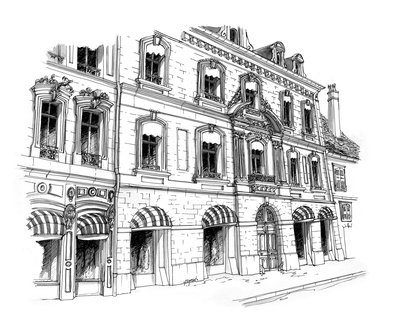
L'ancien Auditoire - F.JEANPARIS History & HeritageThe old auditorium
From 1743 to 1867, Druhen-Vandel house served as a courthouse - then referred to as an auditorium - and a prison. Here, Mirabeau was tried for “seduction, abduction and adultery” and was acquitted after pleading on his own behalf. The building itself was built based on Louis Girod’s design and is constructed around an internal courtyard adorned with a turret. This is a fine example of the architecture of its time. (PNRHJ - Un tour en ville, “A tour of the town”)
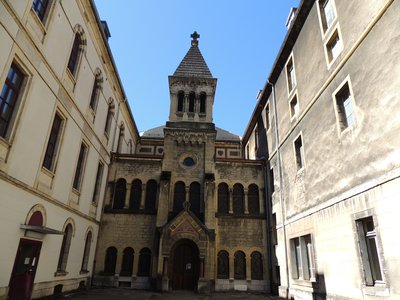
Hôpital Saint-Étienne - PNRHJ - F. Jeanparis History & HeritageSaint-Étienne hospital
Founded and funded by the nuns during the 12th century, Saint-Joseph hospital was partially destroyed during the Ten-Year War. The hospital is not only of historic interest, it also has two unique chapels - one in the baroque style, the other in Byzantine style - and a beautiful apothecary. (PNRHJ - Un tour en ville, “A tour of the town”)

Église Saint-Bégnigne - PNRHJ - F. Jeanparis History & HeritageSaint-Bénigne church
Having been rebuilt on several occasions, after the village was taken by Bernard of Saxe-Weimar and later after two fires, the Saint-Bénigne church is difficult to date; however, one document does prove that it existed during the 12th century. Inside, the church has many remarkable glass windows and sculptures. (PNRHJ - Un tour en ville, “A tour of the town”)
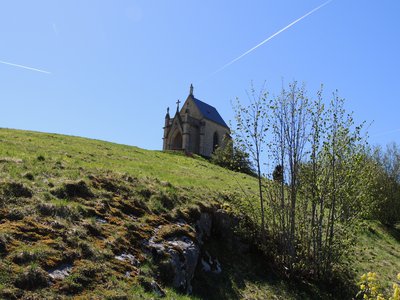
Chapelle de l'Espérance - PNRHJ - F. Jeanparis History & HeritageNotre-Dame de l’Espérance chapel
Designed by architect Girod in neo-gothic style, this chapel was built on Mount Molar during the 19th century on the orders of the priest Lallemand, to thank the Virgin for having protected Pontarlier from the cholera epidemic that had spread to Franche-Comté. (PNRHJ - Un tour en ville, “A tour of the town”)
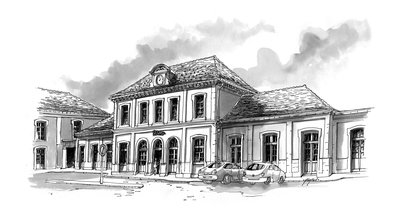
La gare - Illustration de François Pageaut History & HeritageThe train station
The train station was created following the opening of the Franco-Swiss line, which was a major asset for development in a region in which the road network was not yet fully operational. As a result, there was a bitter fight between Dole and Besançon for the railhead. Ultimately, this fight was won by the Jura and in 1860, the first stretch between Neuchâtel and Pontarlier was inaugurated. (PNRHJ - Un tour en ville, “A tour of the town”)
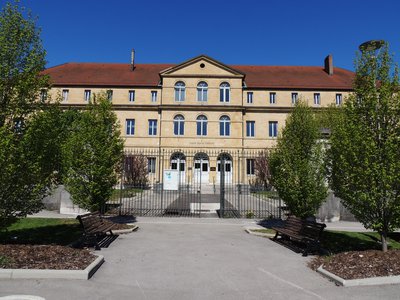
Collège Philippe Grenier - PNRHJ - F. Jeanparis History & HeritagePhilippe Grenier secondary school
Philippe Grenier, a native of Pontarlier, lived from 1865 to 1944. He is remembered by locals for having been a doctor to the poor, but also for having been the first Muslim member of the French Parliament, elected to the Chamber of Deputies in 1896. Philippe Grenier was therefore a Muslim in a Catholic country, promoting a lifestyle without the consumption of alcohol in the land of absinthe, and yet respected for his integrity and devotion to the most disadvantaged. (PNRHJ - Un tour en ville, “A tour of the town”)
Description
 ), descend rue de la Gare to rue de la République.
), descend rue de la Gare to rue de la République.Head to Place d’Arçon, on your left. From here, you can see the Saint-Pierre gate at the end of the road.
From the square, take rue de la Halle near the theatre. At the end of the road, head to the old barracks via place des Bernardines and place Cretin, on your right.
Go to the bridge across the Doubs by heading through place Jules Pagnier and rue de Morteau.
From here, make a round trop (1.2 km) to the Armand Guy distillery via rue des Lavaux.
On returning to rue de Morteau, enter the park on the edge of the Doubs and follow the embankments on a little adapted path; this will take you to the other side of the park. Join up with rue de la République by leaving the park through rue Julez Mathez, where you will find the Jeanne d’Arc high school.
On arriving at rue de la République, head left until you reach another bridge over the Doubs.
From here, make a round trip to the Hospital to observe its facade and the two chapels that can be seen from the road.
On returning to rue de la République, after crossing the bridge once more, head down rue Montrieux and take rue Gambetta on your right to reach place Saint-Bénigne and the church.
From the square, head to the train station vie rue Tissot.
From here, you can head directly to the Tourist Office via rue de la Gare. You can also make a round trip of under 2 km to the Chapelle de l’Espérance, with a stunning viewpoint over the whole city. It can be accessed by heading down rocade George Pompidou until you come to rue du Stand, then head under the railway and take rue de la Chapelle (yellow waymarking) directly to the viewpoint.
- Departure : Tourist Office, Pontarlier
- Arrival : Tourist Office, Pontarlier
- Towns crossed : Pontarlier
Forecast
Recommandations
This discovery trail unfolds in an urban environment and carries hikers along pavements and pedestrian crossings.
The trip to the chapel is taken via a tarmac road, however due to the unlevel ground, access is difficult for pushchairs and Joëlettes.
Most parking spaces in the town centre may be in the blue zone, you will therefore need to obtain a parking disc.
Do not hesitate to visit the town’s Tourist Office, located at 14 bis rue de la Gare.
Information desks
Tourist information centre - Pontarlier
14 bis rue de la Gare, F-25300 Pontarlier
Transport
To visit and get about in the High-Jura, visit www.reshaut-jura.fr, the eco-mobility portal listing all means of transport within the Park.
Access and parking
Pontarlier is accessible via the N57, the D47, the D437, the D67B and the D72.
Parking :
Accessibility
- Emergency number :
- 114
Report a problem or an error
If you have found an error on this page or if you have noticed any problems during your hike, please report them to us here:

